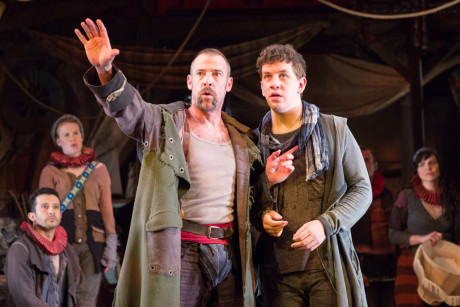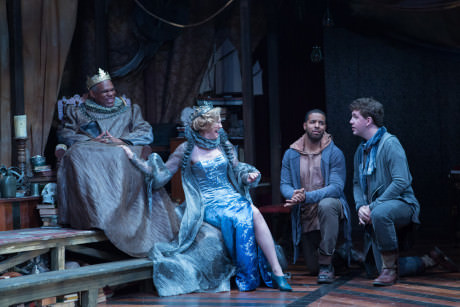Rosencrantz and Guildenstern Are Dead at the Folger Theatre is a sumptuously original production of the breakthrough play of one of England’s greatest living playwrights. “I write plays” Tom Stoppard once said, “because dialogue is the most respectable way of contradicting myself.” The play is rife with paradox, wordplay, and timeless wit. Stoppard himself referred to it as a comedy, and there is much comedy here, along with a serious undertone of inquiry about the nature of fate vs. free will, life vs. death, on vs. off stage.

As we begin, Rosencrantz (Romell Witherspoon) and Guildenstern (Adam Wesley Brown) are flipping coins together. Somehow, the coin repeatedly comes up heads. It is a pleasure to watch these two young actors derive every possible shade of meaning, humorous, existential, or both, from the alternately philosophical and matter-of-fact dialogue.
They are joined by a wandering group of players, led by The Player, Ian Merrill Peakes, whose athletic, multifaceted performance gives a tempestuous energy to his every scene. The Tragedians—Maggie Donnelly, Luis Alberto Gonzalez, Stephen Russell Murray, Jacob Yeh, and Rachel Zampelli, appear in an astounding variety of roles, succeeding beautifully in each one.
As The Player says, “I can do you blood and love without the rhetoric, and I can do you blood and rhetoric without the love, and I can do you all three concurrent or consecutive, but I can’t do you love and rhetoric without the blood. Blood is compulsory—they’re all blood, you see.”

Rosencrantz and Guildenstern are in fact two minor characters in Shakespeare’s Hamlet, and several scenes from Hamlet are included. The focus here is on the hapless Rosencrantz and Guildenstern, who are much more confused about their situation than they are in Shakespeare’s play, and, needless to say, far more vocal about it.

The excellent Andy Prosky is an unctuous Polonius, with a Cheshire cat grin and an insinuating manner. Craig Wallace is an outstanding Claudius (this would be a wonderful role for him—Hamlet, anyone?} Brynn Tucker is a lovely Ophelia, and Kimberly Schraf is equally fine as Gertrude. As Hamlet, Biko Eisen-Martin is a thoughtful presence, who can explode in rage or gaze in enraptured agony depending on what the scene requires.
Director Aaron Posner has created a production which has not only physical beauty but a never-ending flow of ideas, action, light, and sound. Posner refers to the play as a “linguistic funhouse” and he captures perfectly the playwright’s playful approach to the multiple realities of art, life, and death. In an interview with the Paris Review, Stoppard quotes Peter Brook as saying, “The theatre has its roots in something holy.” In Rosencrantz and Guildenstern Are Dead, this most intellectual of playwrights faces the great questions of life like a philosopher or a theologian. Answers, as in most works of art, are beside the point.
Costumes by Helen Q. Huang are exquisite. The “theatrical attic” setting (Scenic and Properties Design by Paige Hathaway), is delightfully eccentric, full of Hamlet volumes and momentos. Lighting Design by Thom Weaver is visually appealing and evocative. Eric Shimelonis’ Music Composition and Sound Design add the final touch to this stunningly innovative production.
Stoppard has the unique ability, as Posner notes, to “effervesce over the void.”
Running Time: Two and one-half hours, with one 15-minute intermission.
Rosencrantz and Guildenstern Are Dead plays through June 21, 2015 at Folger Theatre at the Folger Shakespeare Library—201 East Capitol Street, SE, in Washington, DC. For tickets, call the box office at (202) 544-7077, or purchase them online.
LINK
‘Rosencrantz and Guildenstern are Dead’ at Folger Theatre by Robert Michael Oliver in his column ‘Spine.’





